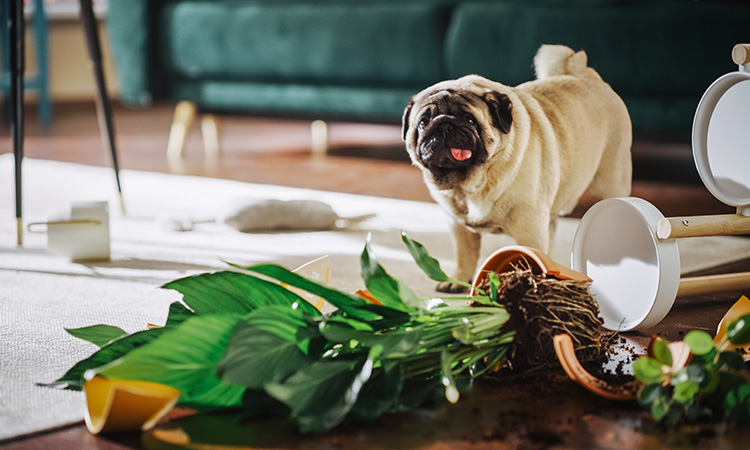A Guide to Handle Separation Anxiety in Dogs
A Guide to Handle Separation Anxiety in Dogs

Separation anxiety in dogs is a common behavioral issue that can lead to significant distress for both the dog and its owner. This condition manifests when a dog experiences extreme anxiety when separated from their owner, resulting in destructive behavior, excessive barking, and even physical symptoms like vomiting or diarrhea. Understanding and addressing this issue is crucial for the well-being of your pet and the harmony of your household. In this blog, we’ll explore the causes, signs, and strategies to manage and prevent separation anxiety in dogs.
What Causes Separation Anxiety in Dogs?
Separation anxiety can develop for various reasons, including:
1. Change in Routine: Dogs are creatures of habit. A sudden change in their daily routine, such as a new job that requires you to be away more often, can trigger anxiety.
2. Traumatic Experiences: Dogs that have been abandoned, rehomed, or experienced a traumatic event may develop separation anxiety.
3. Lack of Socialization: Puppies that haven’t been properly socialized may become overly dependent on their owners, leading to anxiety when left alone.
4. Genetics: Certain breeds are more prone to anxiety-related disorders, including separation anxiety.
Recognizing the Signs of Separation Anxiety
Identifying separation anxiety is the first step toward helping your dog. Common signs include:
1. Excessive Barking or Howling: Persistent vocalization when left alone is a hallmark of separation anxiety.
2. Destructive Behavior: Chewing furniture, digging at doors, or scratching windows are common behaviors in anxious dogs.
3. Pacing and Restlessness: Dogs with separation anxiety may pace in a fixed pattern when you’re about to leave.
4. Accidents Indoors: Even house-trained dogs may urinate or defecate indoors when anxious.
5. Escape Attempts: Some dogs will attempt to escape from confined areas, leading to injury.
6. Excessive Drooling, Panting, or Shivering: Physical signs of stress, such as drooling or panting, are often observed.
Effective Strategies to Manage Separation Anxiety
Addressing separation anxiety in dogs requires patience, consistency, and a tailored approach. Here are some effective strategies:
1. Gradual Desensitization
Gradual desensitization involves slowly acclimating your dog to being alone. Start by leaving your dog alone for short periods and gradually increase the time. Here’s how:
• Practice Departures: Start by putting on your shoes, grabbing your keys, and then sitting down without leaving. Repeat until your dog shows no reaction.
• Short Absences: Begin with very short departures (a few seconds to a minute) and slowly increase the time as your dog becomes more comfortable.
• Stay Calm: Avoid dramatic goodbyes or greetings. Keep departures and arrivals low-key to minimize anxiety.
2. Create a Safe Space
Designate a comfortable area where your dog feels secure. This could be a crate or a specific room with your dog’s favorite toys, a bed, and perhaps an item of clothing with your scent. Ensure this space is associated with positive experiences.
3. Exercise and Mental Stimulation
A well-exercised dog is generally calmer and less prone to anxiety. Ensure your dog gets enough physical exercise, which can be complemented with mental stimulation through interactive toys, puzzle feeders, or obedience training.
• Interactive Toys: Toys like Kongs, which can be filled with treats, keep your dog engaged and distracted while you’re away.
• Puzzle Feeders: These encourage your dog to work for their food, providing mental stimulation that can reduce anxiety.
4. Training and Commands
Teaching your dog commands like “stay” and “wait” can help build their confidence in being alone. Use positive reinforcement to reward calm behavior during short absences.
5. Use of Calming Aids
There are several products designed to help calm anxious dogs, including:
• Pheromone Diffusers: These release a synthetic version of the calming pheromones that mother dogs produce.
• Calming Supplements: Natural supplements containing ingredients like L-theanine or chamomile can help reduce anxiety.
• Thundershirts: These snug-fitting garments apply gentle pressure, similar to swaddling a baby, which can have a calming effect.
6. Seek Professional Help
If your dog’s anxiety is severe, consider consulting a professional dog trainer or a veterinary behaviorist. They can develop a personalized plan that may include behavioral therapy or, in some cases, medication.
Preventing Separation Anxiety in Puppies
Preventing separation anxiety is easier than treating it. Here are some tips for new puppy owners:
• Start Early: Gradually get your puppy used to being alone from a young age. Begin with short separations and slowly increase the time.
• Encourage Independence: Teach your puppy to enjoy alone time by providing them with toys and treats when they’re alone.
• Avoid Reinforcing Clinginess: While it’s tempting to spend every moment with a new puppy, ensure they have time alone to prevent over-dependence.
Conclusion
Separation anxiety in dogs is a serious issue that can affect your dog’s quality of life and your household’s peace. By understanding the causes, recognizing the signs, and implementing the right strategies, you can help your dog feel more comfortable when left alone. Remember, managing separation anxiety takes time and consistency, but with patience and the right approach, you can help your dog overcome their fears and lead a happier, more relaxed life. If you’re struggling with your dog’s anxiety, don’t hesitate to seek professional help. The well-being of your furry friend is worth the effort.
Disclaimer The above information is for illustrative purposes only. For more details, please refer to policy wordings and prospectus before concluding the sales.










 Health Insurance
Health Insurance  Travel Insurance
Travel Insurance  Car Insurance
Car Insurance  Cyber Insurance
Cyber Insurance  Critical Illness Insurance
Critical Illness Insurance
 Pet Insurance
Pet Insurance
 Bike/Two Wheeler Insurance
Bike/Two Wheeler Insurance  Home Insurance
Home Insurance  Third Party Vehicle Ins.
Third Party Vehicle Ins.  Tractor Insurance
Tractor Insurance  Goods Carrying Vehicle Ins.
Goods Carrying Vehicle Ins.  Passenger Carrying Vehicle Ins.
Passenger Carrying Vehicle Ins.  Compulsory Personal Accident Insurance
Compulsory Personal Accident Insurance  Travel Insurance
Travel Insurance  Rural
Rural 











